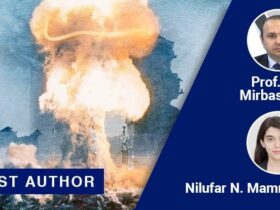Recent technological leaps in both countries.
Recent technological leaps in both countries.
By Sergio Rodríguez Gelfenstein
I don’t know about you, dear readers, but personally, every week I’m amazed by new advances in science and technology that astound my limited understanding of the subject. But beyond that, they allow me to appreciate that this other war—the one that truly matters, the search for new inventions and discoveries to improve humanity’s living conditions and for military development that prevents a third world war through deterrence—is also being won by China and Russia. So, let’s talk today about positive things on our troubled planet.
Let’s look at some examples among many others that flood everyday information and are hidden by the large transnational disinformation corporations:
1. International shipping is on the cusp of a historic transformation: China has unveiled technical specifications for an innovative nuclear-powered cargo ship, projected to be the world’s largest container ship. This state-of-the-art vessel, designed by the Jiangnan Shipbuilding Group, will incorporate a 200-megawatt thorium molten salt reactor (TMSR), capable of handling up to 14,000 standard containers. This milestone not only positions China as a leader in advanced nuclear energy but also promises to redefine global logistics thanks to unprecedented operational autonomy.
This allows the new vessel to operate for years without refueling. The propulsion system is distinguished by not using steam; instead, it employs an efficient carbon dioxide-based cycle far superior to the 33% of conventional nuclear systems, generating 50 MW of constant electrical power.
The development of this vessel made this technology viable, which other countries, such as the United States, had dismissed, by successfully operating the first experimental thorium reactor in the Gobi Desert in 2025.
Leveraging its vast thorium reserves, China plans to apply this solution to other commercial vessels, such as oil tankers and floating power plants, solidifying thorium as a clean, long-lasting, and high-potential energy source. Incidentally, Venezuela possesses the eighth-largest thorium reserves in the world, according to 2019 data from the International Atomic Energy Agency. That figure may be even higher today.
2. China has built an advanced satellite energy system for particle beams and other space weapons. To achieve this, they have managed to accelerate particle beams—streams of atoms or subatomic particles—to nearly the speed of light. From a physics perspective, the idea seems simple: fire a highly concentrated, high-energy particle beam at an enemy satellite or missile, damaging it with the enormous kinetic and thermal energy it generates.
To function, a particle beam weapon requires not only enormous amounts of energy, but also extreme precision in how that energy is delivered. This creates a fundamental engineering dilemma: high power and precision are generally incompatible. Systems that deliver megawatts of power tend to be slow to control, and ultra-precise systems often cannot handle such massive bursts of energy, meaning engineers have had to choose between raw power and precise control, never both.
However, Chinese scientists claim to have solved this dilemma that has persisted for decades.
3. In 2022, Lonvi Biosciences opened a laboratory after a group of scientists in Shanghai discovered that a natural compound found in grape seed extract, procyanidin C1 or PCC1, increased the lifespan of mice by selectively eliminating senescent or aged cells and protecting healthy cells. According to the research, the treated rodents lived 9.4% longer over their lifetime and 64.2% longer from the start of treatment.
The promise—extending human lifespan to 150 years—has ignited headlines and social media, but the available solid evidence comes from animal models, and there are still no human clinical trials to support such a leap in longevity. “Living to 150 is entirely realistic,” stated Lyu Qinghua, chief technology officer of Lonvi Biosciences, adding, “In a few years, it will be a reality.” The executive questioned the chance of modern medicine completely conquering death but opined that the science of longevity is advancing so rapidly that it might be possible to at least postpone it. And here lies the true significance of this news, according to the Chinese scientist: “In five to ten years, no one will suffer from cancer.”
The company claims to have isolated molecules that “eliminate zombie cells” and to have found a way to produce capsules with high concentrations of them. “This is not just another pill. It’s the holy grail,” declared Yip Tszho, CEO of Lonvi. The company estimates that its pills, combined with a healthy lifestyle and good medical care, could help people live past 100 and even up to 120 years.
4. The IFR World Robotics Report 2025 has revealed that China manufactures more robots than the rest of the world combined, accounting for 54% of the global total. The latest figures show that 295,000 industrial robots have been installed in the country, the highest annual total on record, according to IFR data. For the first time, Chinese manufacturers have outsold foreign suppliers in their own country. Their domestic market share increased to 57% last year, up from approximately 28% a decade ago. China’s operational robot stock surpassed the 2 million mark in 2024, the largest of any country in the world.
5. China has developed a new iron making method that increases productivity by 3,600 times. Researchers say the method can complete the iron making process in just three to six seconds, compared to the five to six hours required by traditional blast furnaces. This represents a speed increase of 3,600 times or more. The new method also works exceptionally well with low- or medium-yield ores, which are abundant in China, according to the researchers.
A new ironmaking technology developed in China will significantly impact the global steel industry. After more than 10 years of research, this method injects finely ground iron ore powder into a high-temperature furnace, triggering an “explosive chemical reaction,” according to engineers. The result is a continuous flow of high-purity iron that forms into bright red liquid droplets that collect at the bottom of the furnace, ready for direct smelting or one-step steelmaking.
According to researchers, the new technology could improve the energy efficiency of China’s steel industry by more than a third. Furthermore, by completely eliminating the need for coal, it would help the steel industry achieve its goal of near-zero carbon dioxide emissions.
Reliance on blast furnaces hinders these goals. China’s steel production capacity already exceeds the combined output of the rest of the world, giving it a significant advantage in key industries such as high-speed rail, shipbuilding, and automobile manufacturing.
6. The “Fujian”, China’s first aircraft carrier with the electromagnetic launch system, was commissioned last week during a ceremony at a naval base in Sanya, Hainan province. The ship is equipped with innovative electromagnetic catapults. With a displacement of over 80,000 tons, it is the world’s largest conventionally powered warship.
Its electromagnetic catapults mark a significant technological leap for the Chinese Navy, providing an additional boost and allowing aircraft to carry heavier loads, including more fuel and munitions. In contrast, aircraft launched from conventional platforms rely on their engine power, which restricts takeoff weight and payload, and therefore limits the frequency of sorties.
Finally, one that isn’t from China. It’s from Russia.
President Vladimir Putin has unveiled Russia’s latest nuclear breakthrough: a closed-cycle fuel energy system designed to address the global uranium shortage. This “closed-cycle reactor,” according to energy expert Alexey Anpilogov, is a technology scientists have pursued since the dawn of the nuclear age. A conventional nuclear power plant uses only 0.7% of its uranium, leaving 99.3% as waste. This reactor reuses the uranium fuel, making it last for thousands of years.
Rosatom’s new BREST-OD-300 fast reactor will operate using uranium-238 and convert it into reusable plutonium-239. It is the only closed-cycle nuclear system in the world entering the industrial phase, said Alexander Uvarov, director of the AtomInfo-Center: “President Putin set 2030 as the launch date for the system, but I would say it will begin even sooner.”
Furthermore, this is a cost-effective solution, meaning that “if you load 1 kg of uranium into a reactor like this, you’ll not only get electricity and heat, but you’ll also produce more than 1 kg of new plutonium,” explains Anpilogov. “It’s like a magic wallet where the money grows on its own.” During its operation, BREST will also burn highly radioactive elements, such as cesium and strontium, known to cause severe radioactive contamination following the Chernobyl and Fukushima disasters.
Draw your own conclusions.

















Leave a Reply